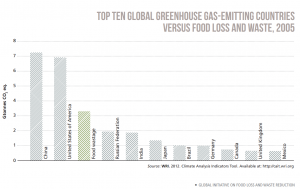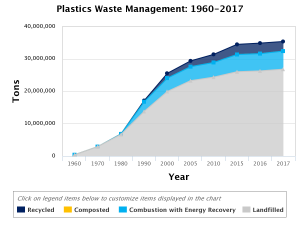Pornpimol Scheuchzer
Most environmental and health impacts of food production are not economically valued. We are as a customer have paid its cost so far by not the money in our pocket but by our health and well-being. In general, food price is calculated based on the cost of materials, ingredients, labor, packaging, transportation as for example. This market price is different to its comprehensive cost to society and environment. In this article, I will focus on two costs that the food price have not been taken into account, 1) the cost of food waste and 2), the cost of health.
Cost of food waste on CO2 emission
Food and Agriculture Organization (FAO) estimation of yearly global food loss and waste by quantity at roughly 30% of cereals, 40-50% of root crops, fruits and vegetables, 20% of oilseeds and 35% meat, fish and daily product. In low-income countries food loss results from wide-ranging; managerial, technical limitation and marketing system while in medium and high-income countries relate mainly to consumer behavior and the policies. Current trends in world population and consumption preference will continues boosting demand for food. The existing measures focused on increasing production, the magnitude of loss and waste is too large to be ignored. Approximately, one-third of the edible parts of global food produced for human consumption is estimated to be lost for wasted. Barrera and Hertel, reported that, Food lost and wasted presents a social dilemma, even food loss and west is rising, the global population facing chronic deprivation. Food waste at the consumer level in medium and high-income countries is as high as total net food production in Sub Sahara Africa. In Switzerland, The institute of Ecological System Design at ETH Zurich has calculated the environmental impact of avoidable food waste linked to food consumption. The study report that food waste in Switzerland accounted to 50% of the environmental impact of all private motor vehicles in Switzerland. Similar to other developed countries which most of the food waste generated from households (38%) followed by processing (27%) catering (14%), agriculture (13%) and wholesale and retail trade (8%). Producing food that is not consumed resulted in unnecessary CO2 emissions, biodiversity loss, and land and water consumption, which are the main effect on environmental impact. If food wastage were a country. It would be the third largest emitting country in the world. Have this environmental cost included in the food price?

Cost of food packaging waste
The estimation of packaging industry in 2009 reported that food accounts for of 50% of the global consumer. The packaging materials that have been used includes glass, paper, and plastic, metal and wood. Due to various functionality advantages such as termosealability, microwaveability, optical properties and unlimited sizes and shapes therefore plastic rated one of the top used among those listed. Unlike food, food packaging remained after food have been consumed, without reused and recycling process the number of produced food packaging will remain equals to food packaging waste. Thanks to the material properties of particular types such as metal, paper, glass or metal that can be reused or recycled. Incompatible to those recyclability materials, only 8% of plastic from total generated has recycled. The remained unrecycled plastic has ended up in the landfilled or later on ended up in the oceans, generating drastic environmental issues. Do you think a cheap price of a bottle of water has already taken into account of this issue?

Cost on health
There is an interesting argument was that diet quality played a key part in social inequalities in health. This firstly observed in developing counties, which continue to be observed in industrialized countries including Europe and the United States. There are many studies investigating the relationship between obesity and poverty. The one highlight finding was that high prevalence of obesity in low-income class may be reinforced by the low price of high energy-dense food. What could be the reason that people willing to pay for unhealthy food. Most people require between 2000 and 2500 kcal per day, and strive to obtain the daily energy ration at affordable cost. The most important factor for people in choosing and preparing foods was to satisfy hunger. Unfortunately, food richer in energy (high in fat and sugar) is much cheaper compare to food that rich in heath protective nutrient (like fruit and vegetable). Moreover, good-tasting fat and sweets are easy to consume in excess, their palatability, availability and convenience made low-cost calories the likely direct precursors of weight gain. How Food companies can sell such a high-density energy product at the low cost and gaining a lot of benefit at the same time? The answer is, added sugars and fats product are easier to produce, process, transport and store than are perishable meats, dairy products or fresh vegetables or fruits. WHO has estimated that in 2016, more than 650 million adult were obese and 40 million children under the age of five were overweight or obese in 2018.

Excess weight harms health in many ways. It increases the risk of developing conditions such as diabetes, heart disease, osteoarthritis, and some cancers, to name just a few, and reduces the life span. Treating obesity and obesity-related conditions costs billions of dollars a year. In 2005, U.S spent 190 billion US dollar on obesity-related health care. The estimation form OECD countries (including Switzerland) in the next 30 years, obesity in these countries will claim more than 90 million lives, with life expectancy reduced by 3 years, the GDP will be reduce by 3% and final it will exact a heavy toll on personal budgets. Until now, you may get an idea that the low price high dense food may course serious consequences on health and well-being. This issue has already been occurred worldwide individual or population. Fat and sugar not only diet that show the adverse effect on health, high consumption of salt was reported to associated with hypertension and fatal stroke. The consequence of consuming energy dense food may take time to show their effect on the health, finishing a can of sugary drink will not cause diabetes, obesity or stroke right away, with this, may be make people less concern on what their eat. What about if what you eat is directly effects your individual cost.
Individual health insurance Once a year, I received a questionnaire from my health insurance company, spending 5 minutes answering the questionnaire related to my physical activity, eating habit, frequency of consuming processed food. Insurance will evaluated my answer and give me 15% discount on medical costs. In the near future when world is drive on AI, when shopping, payment and all data are well connected. Is it possible that insurance company tract on what you eat from the money you have spent on food, where you went for eat or how many step you walked per day. Base on that data, insurance company calculated the individual price. This a piece of information is based on my experience and personal opinion but in the future every unforeseen can be promised.
Sustainable food production
Environmental impacts of food production and health impact from consumption of unhealthy food are not economically take into account on food price calculation. In the future, what if the price you paid for the food has included the cost on environmental and health impacts. Is this new pricing could promote more sustainable food production, reducing availability of unhealthy food. Calculating true price is more challenging and involves technical challenging, to transfer qualitative impact values to quantitative. One of the recommendation from WHO to reduce energy dense consumption is a tax policy on sweetened beverages, but this suggestion have to make against the classic arguments “eating sugary or fatty food is not an absolute cause or the only cause of overweight and obesity“. Other sentiment arguments against taxing sugary beverages discovered by Barry et al is “ taxes were a money grab by politicians or an unacceptable government intrusion into our personal lives“ this statement is obviously root to the public problem. This policy instrument will take more time and sophisticated efforts to make it happen. In term of processing, instead of focusing on increasing production volume, the focus should move forward on minimizing waste.
References
Barrera EL, Hertel T: Global food waste across the income spectrum: Implications for food prices, production and resource use. Food Policy 2020:101874.
Dorfman L: Talking About Sugar Sweetened–Beverage Taxes: Will Actions Speak Louder Than Words? American journal of preventive medicine 2013, 44:194-195.
Drewnowski A: Fat and sugar: an economic analysis. J Nutr 2003, 133:838s-840s.
Drewnowski A: The real contribution of added sugars and fats to obesity. Epidemiol Rev 2007, 29:160-171.
Goettler A, Grosse A, Sonntag D: Productivity loss due to overweight and obesity: a systematic review of indirect costs. BMJ open 2017, 7.
Tremmel M, Gerdtham U-G, Nilsson PM, Saha S: Economic burden of obesity: a systematic literature review. International journal of environmental research and public health 2017, 14:435.
https://doi.org/10.1038/s43016-020-0070-5
https://www.bafu.admin.ch/bafu/en/home/topics/waste/guide-to-waste-a-z/biodegradable-waste/types-of-waste/lebensmittelabfaelle.html
https://www.oecd.org/newsroom/tackling-obesity-would-boost-economic-and-social-well-being.htm
https://www.who.int/news-room/fact-sheets/detail/obesity-and-overweight
https://www.theguardian.com/environment/2018/jan/17/nearly-1m-tonnes-every-year-supermarkets-shamed-for-plastic-packaging
Media Attributions
- FAO-fig1
- chart
- Eat-Home-Cooked-Food-Skip-TV-During-Meals-To-Avoid-Obesity-Study